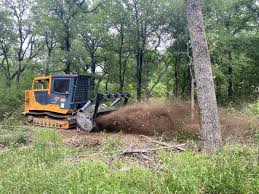Austin Brush Removal is essential for maintaining the health, safety, and aesthetic appeal of any property. Overgrown brush can quickly transform a well-maintained landscape into an unkempt and uninviting space. It creates a breeding ground for pests, increases the risk of wildfires, and limits the usability of outdoor areas.
By investing in brush removal, property owners can improve the overall look and functionality of their land while enhancing safety and environmental health. Removing brush also increases property value, making it more appealing to potential buyers and investors. Proper brush removal ensures that the landscape remains clean, open, and easy to maintain, contributing to a more enjoyable and versatile outdoor environment.
One of the primary benefits of brush removal is improving the visual appeal of the property. Overgrown brush creates a cluttered and chaotic appearance that detracts from the natural beauty of the landscape. Dense vegetation and tangled undergrowth can make a property look abandoned and neglected, reducing its curb appeal and market value. Removing brush clears the view of attractive landscape features such as trees, gardens, and architectural elements, allowing the property’s natural beauty to stand out. A clean and open landscape creates a more inviting and welcoming atmosphere, encouraging greater use and enjoyment of outdoor spaces. The improved aesthetics also create a positive impression on visitors, neighbors, and potential buyers, increasing the property’s overall appeal and value.
Safety is another key reason why brush removal is important. Overgrown brush increases the risk of fire, especially during dry seasons. Dead branches, leaves, and dense vegetation create a highly flammable environment that can quickly ignite and spread, endangering structures and lives. Removing brush reduces the fuel available for fires and creates natural firebreaks that help slow the spread of flames. This reduces the risk of property damage and protects residents and neighboring properties from fire-related hazards. Brush removal also improves visibility and reduces hiding spots for wildlife and trespassers, increasing overall security. Clear and well-maintained landscapes make it easier to spot potential hazards and ensure that the property remains a safe and secure environment.
Pest control is another major benefit of brush removal. Dense brush provides an ideal habitat for pests such as rodents, insects, and snakes. These pests can damage vegetation, invade homes, and pose health risks to residents and pets. Removing brush eliminates the shelter and food sources that attract pests, reducing their population and minimizing the risk of infestations. This creates a healthier and more comfortable living environment and reduces the need for chemical pest control treatments. Brush removal also reduces the risk of disease transmission by removing the conditions that allow pests to thrive and reproduce. A pest-free environment enhances the overall quality of life for residents and increases the value and desirability of the property.
Brush removal also promotes the health and growth of desirable plants and trees. Overgrown brush competes with grass, flowers, and trees for nutrients, sunlight, and water. Dense undergrowth can block sunlight and restrict airflow, creating an unhealthy environment for vegetation. Removing brush allows sunlight to reach the soil and improves air circulation, creating better growing conditions for grass, flowers, and ornamental plants. This encourages healthier and more vibrant plant growth, enhancing the overall beauty and appeal of the landscape. Brush removal also helps prevent the spread of invasive species that can choke out native plants and disrupt the ecosystem. By removing invasive brush, property owners can create a balanced and thriving landscape that supports diverse plant and animal life.
Increasing the usability of outdoor spaces is another advantage of brush removal. Overgrown brush limits access to certain areas of the property and creates barriers to outdoor activities. Removing brush creates open and accessible spaces that can be used for recreation, gardening, and landscaping. Cleared land provides more room for outdoor furniture, play areas, and entertainment spaces, making the property more functional and enjoyable. Brush removal also creates opportunities for landscaping improvements such as installing pathways, gardens, and water features. This enhances the property’s overall value and creates a more versatile and appealing outdoor environment. The added functionality makes the property more attractive to buyers and increases its marketability.
Brush removal also supports environmental health by improving soil quality and water drainage. Overgrown brush can create compacted soil that prevents proper water absorption and increases the risk of erosion. Removing brush loosens the soil and allows water to penetrate more effectively, promoting healthier root growth and reducing runoff. Improved drainage prevents water from pooling and creating breeding grounds for mosquitoes and other pests. Brush removal also helps maintain the natural balance of the ecosystem by encouraging the growth of native plants and reducing competition from invasive species. This creates a healthier and more sustainable landscape that supports local wildlife and enhances biodiversity. A well-balanced ecosystem contributes to the overall health and stability of the property, increasing its long-term value and appeal.
Professional brush removal services offer several advantages over DIY methods. Trained professionals have the knowledge and equipment to handle various types of brush and terrain safely and efficiently. They can assess the property and develop a strategic removal plan that minimizes environmental impact and preserves valuable vegetation. Professional services also have access to specialized equipment such as brush cutters, mulchers, and chippers, which allow for faster and more effective clearing. Hiring professionals reduces the risk of injury and ensures that the job is completed thoroughly and efficiently. Professional brush removal also includes proper disposal of debris, ensuring that the cleared material is handled responsibly and does not create additional waste or environmental damage.
Brush removal also plays a crucial role in preventing soil erosion and protecting water quality. Overgrown brush can create imbalances in the soil, leading to increased runoff and sedimentation in nearby water sources. Removing brush stabilizes the soil and improves water absorption, reducing the risk of erosion and protecting local streams, ponds, and groundwater supplies. This helps maintain the overall health of the ecosystem and prevents damage to surrounding vegetation and wildlife habitats. Improved soil health also promotes the growth of native plants and reduces the need for chemical fertilizers and pesticides, contributing to a more sustainable and environmentally friendly landscape. The long-term environmental benefits of brush removal create a healthier and more resilient property that can withstand changing weather conditions and environmental challenges.
Brush removal also enhances the long-term value and marketability of the property. A cleared and well-maintained landscape is more attractive to buyers and increases the property’s overall worth. Potential buyers are more likely to invest in a property that requires minimal maintenance and offers open and versatile outdoor spaces. The improved safety, accessibility, and visual appeal created by brush removal make the property more desirable and increase its competitive edge in the real estate market. Buyers are also more willing to pay a premium for a property that has been professionally cleared and landscaped, recognizing the value of the investment and the long-term benefits it provides. The increased marketability and value created by brush removal ensure that the property remains a valuable asset and a sound investment for years to come.
Investing in brush removal is a strategic decision that enhances the safety, functionality, and aesthetic appeal of the property. The immediate improvements in appearance and accessibility create a more inviting and enjoyable outdoor environment. The long-term benefits, including increased property value, improved environmental health, and reduced maintenance costs, ensure that the investment in brush removal provides lasting value and returns. Professional brush removal services offer a safe and efficient solution for clearing overgrown vegetation and creating a clean and open landscape. By removing brush and maintaining a well-balanced and healthy ecosystem, property owners can unlock the full potential of their land and create a more valuable and attractive property.





